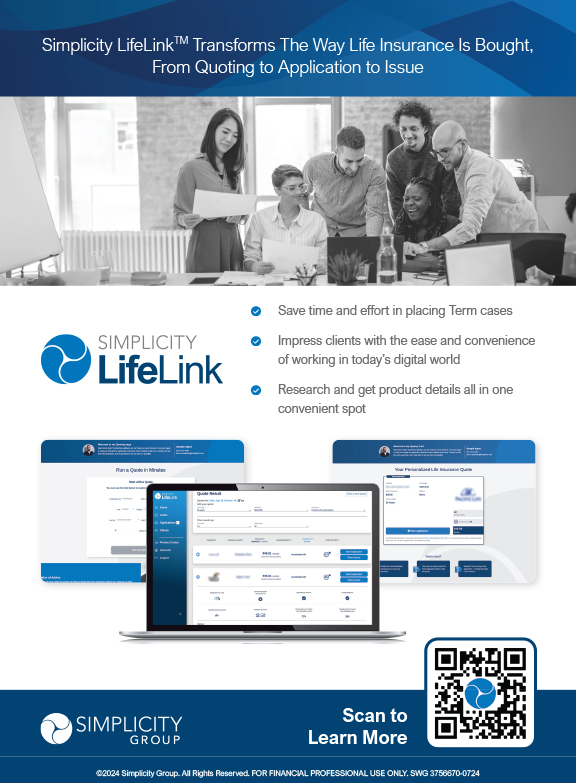The 2018 Milliman Long Term Care Insurance Survey is the 20th consecutive annual review of long-term care insurance (LTCI) published by Broker World magazine. It analyzes the marketplace, reports sales distributions, and details available products.
This year, in addition to individual policies sold directly to individuals or through multi-life groups (primarily small groups) with discounts and/or underwriting concessions, the survey also includes Genworth group sales as part of the multi-life sales. (Genworth is the only insurer issuing new LTCI policies on group policies and certificates.)
More analysis of worksite sales will appear in the August issue of Broker World magazine.
Unless otherwise indicated, references are solely to U.S. stand-alone LTCI sales, excluding exercised future purchase options or other changes to existing coverage. “Stand-alone” refers to LTCI policies that do not include death benefits (other than returning premiums upon death or waiving a surviving spouse’s premiums), annuity, or disability income benefits.
Highlights from This Year’s Survey
Participants
Ten carriers participated broadly in this survey. Seven others provided sales information so we could report more accurate aggregate industry individual and multi-life sales.
CalPERS (the California Public Employees’ Retirement System) is a first-time participant. As shown in the Product Exhibit, its product is comparable to others. However, CalPERS is unique in the long term care space in that it is not an insurance company or a third-party administrator.
As noted above, Genworth’s group line is new to the survey. Genworth’s individual and group lines are counted as a single participant.
The two carriers which sell the most worksite LTCI reported statistical distributions last year but not this year, so this year’s distributions are over-weighted toward individual sales. The inclusion of Genworth’s group product reduces that shift in distribution.
State Farm discontinued stand-alone LTCI sales in May 2018, hence is no longer included in the Product Exhibit.
Although not displaying products, Northwestern LTC provided background statistical information. Auto-Owners, John Hancock, LifeSecure, National Guardian, State Farm, Transamerica and United Security Life contributed to the sales total but did not provide broad statistical information.
Sales Summary
- The 17 carriers reported sales of 70,080 policies and certificates (“policies” henceforth) with on-going premiums ($181,956,656 of new annualized premium, including exercised FPOs) in 2017, compared to our 2016 reported sales (increased to reflect 2016 production from CalPERS and Genworth group and adjusted for small corrections to prior data) of 94,353 policies ($225,838,660 of new annualized premium), a 26 percent drop in the number of policies and a 19 percent drop in the amount of new annualized premium. (A small amount of unreported single premium sales also occurred.) However, as noted in Market Perspective, sales of policies combining LTCI with other risks continue to increase.
- Six insurers (three in the Product Exhibit and three others) sold more premium than in 2016 and five sold more policies.
- Mutual of Omaha and Northwestern reversed position as the top two carriers, combining for more than half of the new sales in terms of premium.
- For the third straight year (and 3rd time ever), our participants’ number of inforce policies dropped, this time by 5.1 percent after 0.3 percent (2016) and 0.2 percent (2015) drops previously.
- Nonetheless, year-end inforce premium increased 6.0 percent in 2017 (2.9 percent in 2016). Inforce premium increases from sales, price increases, and benefit increases (including FPOs), and reduces from lapses, reductions in coverage, deaths, and shifts to paid-up status for various reasons.
Participants’ individual claims rose 6.1 percent and group claims rose 10.3 percent. Overall, the stand-alone LTCI industry incurred $11.1 billion in claims in 2016 based on companies’ statutory annual filings, raising total incurred claims from 1991 through 2016 to $118.9 billion. (Note: 2016 was the most recent year available when this article was written.) Most of these claims were incurred by insurers that no longer sell LTCI. This compares with $9.5 billion of incurred claims in 2015, a 14 percent increase. Combo LTC claims are in their infancy and amounted to $5.9 million. The claim figures are even more startling considering that only 4 percent of 7 million covered individuals were on claim at the end of 2016.
Only 59.0 percent of applications resulted in active policies. This low success ratio contributes to financial advisors’ reluctance to recommend that clients apply for LTCI.
About the Survey
This article is arranged in the following sections:
- Highlights provides a high-level view of results.
- Market Perspective provides insights into the LTCI market.
- Claims presents industry-level claims data.
- Sales Statistical Analysis presents industry-level sales distributions reflecting data from 10 insurers.
- Partnership Programs discusses the impact of the state partnerships for LTCI.
- Product Exhibit shows, for nine insurers: Financial ratings, LTCI sales and inforce, and product details.
- Product Details, a row-by-row definition of the product exhibit entries, with a little commentary.
- Premium Exhibit shows lifetime annual premiums for each insurer’s most common underwriting class, for issue ages 40, 50, 60, and 70, for single females, single males, and heterosexual couples (assuming both buy at the same age), based on $100 per day (or closest equivalent weekly or monthly) benefit, 90-day facility and most common home care elimination period, three-year and five-year benefit periods or $100,000 and $200,000 maximum lifetime buckets, with and without Shared Care and with flat benefits or automatic five percent annual compound benefit increases for life. Worksite premiums do not reflect any worksite-specific discount.
- Premium Adjustments (from our published prices) by underwriting class for each participant.
- Distribution by underwriting class for each participant.
- State-by-state results: Percentage of sales by state, average premium by state and percentage of policies qualifying for Partnership by state.
Market Perspective (more detail in subsequent parts of the article)
- Recently priced policies are based on assumptions that rely on far more credible data, hence premiums should generally be more stable.1 However, consumer access to genetic testing seems to pose a potentially significant threat to insurers, as explained in the “One-Time Risk-Related Questions” area in the Sales Statistical Analysis section.
- Despite the anticipated more stable pricing, many financial advisors presume that currently-issued policies will face steep price increases. It is important to educate them that assumptions underlying current market pricing should produce a lower chance of needing a rate increase. For example, one of the biggest assumptions that is better understood today is voluntary termination assumptions, originally often priced closer to eight percent per year compared to often now less than one percent per year. Because voluntary termination rates in pricing are now close to a “theoretical floor” of zero percent, it is far less likely that rate increases will be required on products priced today, all else equal.
- About half of the participants have increased premiums on policies issued under “rate stabilization” laws. For most of those insurers, the highest cumulative increase on such policies has been 30 percent to 60 percent.
- “Combo” policies (LTCI combined with life insurance or annuity coverage) increased to 256,000 sales totaling more than $4 billion of new premium in 2016 (88 percent life; 12 percent annuity) much of which was from single premium sales, compared to $3.6 billion in 2015. (2017 combo sales were not available when this article was written.) Combo products have increased market share because they include a death benefit (so premiums are not “wasted” for those who never need LTC), are perceived to be more stable, and now offer alternatives besides single premium.
- There are many ideas being discussed by the industry to address LTC financing, including the following:
- Stand-alone LTCI with guaranteed premium and with benefits that float up or down based on experience.
- Life insurance partly pre-paying for LTCI and converting to LTCI at a specified age.
- A tax-favored retirement program that supplements retirement benefits if LTC is needed.
- Industries are becoming more electronic, so we asked one-time questions regarding electronic applications (eApps). Six of 12 respondents currently have eApps. Another three are likely to have eApps by the end of 2018. All but one of the eApps drill down for further information when a question is answered “yes” (the other eApp is used only for simplified underwriting) and all but one send a skeletal record to the advisor. One eApp can be completed by a consumer without advisor assistance. Based on data from two participants, eApps are 71 percent more likely to be in good order and significantly less likely to be declined than previous experience with paper apps (overall, eApps had 19 percent lower declines, despite one carrier having a higher decline rate because their eApps had an older age distribution). Paper apps submitted after an eApp system has been installed are two percent to four percent more likely to be “not in good order” (NIGO) than paper apps prior to the eApp system being installed. That is probably because the most prolific submitters of applications submit fewer applications that are NIGO and also are more likely to adopt eApps quickly. There are mixed results on the decline rate of paper apps after an eApp system is installed. It is surprising that the “cleaner” apps did not reduce processing time; perhaps that is due to an older age distribution. We measured processing time from when the app reaches the insurer, thus ignoring quicker submission by the advisor and possibly speedier movement from advisor to carrier.
- During the course of 2017, the brokerage worksite market reduced to a sole insurer. However, three new unisex offerings appear likely by the end of 2018. Despite that welcome news, it can be hard to find stand-alone LTCI for employers with many young, lower income or female employees, particularly if the employer does not contribute to the cost.
- The average potential future covered LTC costs dropped again for 2017 sales. For the average 57-year-old purchaser in 2017, we project a maximum benefit in 2040 of $254/day, equivalent to an average 2.1 percent compounded benefit increase. The same average purchaser, had he/she purchased last year’s average policy at age 56, would have had $281/day by age 80, equivalent to 2.4 percent compounding. Purchasers may be disappointed if the purchasing power of their LTCI policies deteriorates over time. In addition to the monthly maximum, the average benefit period also dropped, which is not reflected in this calculation.
- If an insurer concludes that a claimant is not chronically ill, the claimant can appeal the decision to independent third-party review (IR), which is binding on insurers. We are aware of only 53 times claimants have resorted to IR, and the insurers’ denials were upheld 89 percent of the time. Most participants have extended IR beyond statutory requirements, most commonly to policies issued prior to the effective date of IR. The existence and voluntary expansion of IR and the insurer success rate when appeals occur help justify confidence in the industry’s claim decisions.
- Only four participants offer coverage in all U.S. states and no worksite insurer does so. Insurers are reluctant to sell in jurisdictions which are slow to approve a new product, restrict rate increases, or have unfavorable legislation or regulations.
- Six of our participants use reinsurers and six use third party administrators. We’d like to recognize their contribution to the LTCI industry. The reinsurers used are General Electric, LifeCare, Manufacturers, Munich, Reinsurance Group of America and Swiss Re. The TPAs are CHCS, Life Plans, LifeCare Assurance, and Long Term Care Group. Other reinsurers and TPAs support insurers which are not in our survey.
Claims
- Ten participants, including one new participant, reported 2017 individual claims but two carriers that contributed claims data last year did not contribute statistical data this year. Only two carriers submitted group claims data. Some companies were not able to respond to some questions or could not respond in a way that justified combining their data with the other carriers for some questions.
- For the nine insurers which reported individual claims for both 2017 and 2016, claim dollars rose 6.1 percent, despite a 6.3 percent decrease in inforce policies.
- For the two group carriers, claim dollars rose 10.3 percent.
- Combining individual and group claims, these 10 insurers paid $3.2 billion in LTCI claims in 2017 and have paid $29.9 billion from inception.
- The LTCI industry has had a much bigger impact than indicated above, because a lot of claims are paid by insurers that no longer sell LTCI.
LTCI claims paid by insurers no longer selling LTCI might differ significantly from data reported below because their claimants might be more likely to have facility-only coverage, be older, etc.
Table 1 shows claim distribution based on dollars of payments, whereas Table 2 shows distribution based on number of claims.
Individual claims shifted significantly away from nursing homes (from 37.4 percent to 32.1 percent) to ALFs (31.2 percent to 35.3 percent). We’ve expected on-going shift away from nursing homes (because of consumer preferences and because an increasing percentage of claims are on comprehensive policies), but about 60 percent of the change in Table 1 is attributable to different insurers providing 2017 claims information than in 2016.
In the distribution based on number of claims (Table 2), a person who received care in more than one venue is counted once for each venue, but not double-counted in the total line.
Eight carriers reported their number of open claims at year-end. Six of the eight insurers reported that their pending number of claims at year-end was between 67 percent and 82 percent of the number of claims they paid during the year.
Table 3 shows average size individual and group claims since inception. Because claimants can submit claims from more than one type of venue, the average total claim should generally be larger than the average claim paid relative to a particular venue. Nonetheless, ALFs consistently show high average size individual claims, probably because:
a) ALF claims appear to last longer compared with other venues.
b) Nursing home costs are more likely than ALF costs to exceed the policy maximum. Hence the maximum daily benefit negates part of the additional daily cost of nursing homes. (Quantified below.)
c) If people maximize the use of their maximum monthly benefits, they’ll spend nearly the same on an ALF as on a nursing home.
d) Although some surveys report that ALFs cost about half as much as nursing homes on average, ALFs often charge more for a memory unit or more substantial care for levels of assistance that align more closely with care provided in a nursing home. Also upscale ALFs seem to cost a higher percentage of upscale nursing home costs than is true of the average ALF.
Some people may have expected that ALF claims would be less expensive than nursing home claims because ALFs cost less per month. But that has not been the case.
Except for home care, the individual average claims rose about one-third in 2017. These increases were also significantly attributable to a change in participants.
The following factors cause our average claim sizes to be understated:
- Roughly ten percent of the inception-to-date individual claims are still open. Our data does not include reserve estimates for future payments on open claims.
- People who recover, then claim again, are counted as though they are multiple insureds. We are not able to add their various claims together.
Past average claim data understates the value of buying LTCI because the many small claims drive down the average claim. LTCI can provide significant financial return for people who need care one year or longer. The purpose of insurance is to protect against a non-average result, so the amount of protection, as well as average claim, is important.
The average group claim is smaller than the average individual claim, but closer this year than in the past due to a change in insurers providing the data. Group claims tend to be smaller because of shorter benefit periods, lower maximum daily benefits, fewer benefit increase features, and more common reduced maximums for home care.
Only two participants were able to answer our one-time questions to study what percentage of claims use the full maximum monthly benefit. One had a higher percentage of claims use the maximum benefit in each cell, especially for ALFs and community care (home care and adult day care), but the two insurers showed the following consistent patterns:
- Nursing home (NH) claims were more likely to use the maximum benefit than ALF claims, which were more likely to use the maximum benefit than adult day care and home care claims.
- Policies with flat benefits were more likely to use the maximum than were policies with increasing benefit maximums (which included policies with FPOs).
Home care claims with monthly determination of benefits are more likely to pay the maximum monthly benefit than home care claims with daily maximums. We did not distinguish claims based on that characteristic, but believe the insurer with fewer community care claims using the full maximum had a higher percentage of policies with daily determination.
Table 5 conveys the false impression that home and adult day care (“community care”) claims are more likely to use the maximum if they have increasing benefits. That result occurred because the insurer with fewer policies using maximum benefits, sold mostly flat community care benefits, while the insurer with more policies using maximum benefits sold mostly increasing community care benefits. As noted above, both insurers found that flat benefits were more likely to be entirely used.
We also asked one-time questions about the average monthly benefit paid by venue. To control the fact that ALF coverage is more common on more recent policies, we limited the question to policies issued between 2000 and 2005 which were on claim in 2017. Three insurers responded:
- The average ALF claim was 0.3 percent higher than the average NH claim for one carrier and only 3.3 percent less for another carrier. For the third carrier, it was 20.4 percent less because their policies did not reimburse 100 percent of the ALF cost up to their NH maximum. Per Table 3, if we mix all years and include more insurers, the average total cost of an ALF claim is 54 percent higher than the average nursing home claim.
- The average home care claim differed markedly by carrier. For one, it was a surprising 87.5 percent of the average nursing home claim. For another it was 47.4 percent (many policies had lower maximums for home care). For the third, it was only 13.1 percent (because of a 50 percent home care maximum and daily determination). Per Table 3, if we mix all years and include more insurers, the average total cost of a home care or adult day care claim is 69 percent as high as the average nursing home claim.
Six insurers were able to provide data regarding their current monthly exposure. The average current monthly maximum benefit per inforce policy ranged from $5,008 to $6,989, with a weighted average of $6,117. Expressed as a percentage of monthly inforce premium, the range was 2433 percent to 3948 percent, with a weighted average of 3148 percent. That means that the maximum monthly (annual) benefit is about 31.5 times the average monthly (annual) premium. Based on past studies, we believe the average inforce benefit period is more than four years, suggesting that the average protection is 126 times as large as the average annual premium, including premium increases which have occurred and ignoring future benefit increases.
While we were putting this article together, a state regulator expressed concern that payment of unjustified claims contributes to LTCI rate increases. We don’t think such claims have had a major impact on rate increases, but we have been glad to see the industry’s strong focus in recent years on ferreting out and resisting fraudulent claims.
Sales Statistical Analysis
Ten insurers contributed significant background data, but some were unable to contribute data in some areas. Seven other insurers (Auto-Owners, John Hancock, LifeSecure, National Guardian, State Farm, Transamerica and United Security) contributed their number of policies sold and new annualized premium, distinguishing worksite from other sales.
Sales characteristics vary significantly among insurers. Year-to-year variations in policy feature distributions may reflect changes in participants, participant practices and designs, participant or worksite market shares and industry trends.
Market Share
Table 6 lists the top 11 carriers in 2017 new premium among those still offering LTCI. Mutual of Omaha continued its surge, moving into first place, with Northwestern a strong second. Together, they produced more than 50 percent of annualized first year premium in 2017. They are followed by five insurers with five percent to 10 percent market share each.
Worksite Market Share
Worksite business produced 22.0 percent of new insureds (see Table 7), but only 13.9 percent of premium because of its younger issue age distribution and less robust coverage. We’ve restated 2016 sales to include Genworth group, demonstrating that the percentage of sales from worksite sales has not changed much from 2016. Worksite sales consist of three different markets:
- Voluntary group coverage generally is less robust than individual coverage.
- Core/buy-up programs have particularly young age distributions, particularly modest coverage levels because a lot of people don’t buy-up and are least likely to insure spouses.
- Executive carve-out programs generally are the most robust. One- or two-couple executive carve-out sales may not qualify for a multi-life discount with some insurers, hence may not be labeled as worksite sales in our analysis.
The amount of worksite sales reported and the distribution of worksite sales among the three sub-markets significantly impact product feature sales distributions. This year’s distributions underweight the voluntary and core/buy-up markets because carriers in those markets shared less statistical data than in the past. More information about worksite sales will appear in the August issue of Broker World magazine.
We asked a one-time question: Recognizing that combo life/LTCI policies are available in the worksite on a guaranteed issue basis (if there is satisfactory participation), do you envision offering worksite stand-alone LTCI policies on a guaranteed issue basis or with underwriting concessions within the next five years? No participant envisioned guaranteed issue, but three insurers envisioned instituting worksite health liberalizations.
Affinity Market Share
Reported affinity sales produced 7.3 percent of new insureds (see Table 8), but only 6.8 percent of premium. About 75 percent of the lower affinity average premium is attributable to the affinity discount. The balance may be due to younger issue age or less robust coverage. Prior to 2016, affinity sales did not include AARP sales.
Characteristics of Policies Sold
Average Premium
As shown in Table 9, the average premium per new insured ranged between $2,322 and $2,497 between 2011 and 2016, then surged to $2,596 in 2017. If we had had the same participants each year, the increase would have been larger. The increase was partly attributable to FPOs, hence overstates the average new sale premium. Three insurers reported average premiums below $1,600, while four insurers were over $3,000, with another at $2,995. The average premium per new purchasing unit (i.e., one person or a couple) also rose, from $3,496 to $3,734 (also inflated by FPOs). The lowest average premium was in Kansas ($2,278) followed by Louisiana ($2,310), while the highest average premium was in New York ($3,942) followed by Connecticut ($3,888). The average inforce premium jumped 8.5 percent to $2,296, due to rate increases and, to a much lower extent, FPO elections and termination of older policies.
Issue Age
Table 10 summarizes the distribution of sales by issue age band based on insured count. The average issue age rose to 56.7, the highest since 2013. The change in participants explains about 25 percent of the increase. Two participants have a minimum issue age of 40, one won’t issue below 30, and two won’t issue below 25.
Benefit Period
Table 11 summarizes the distribution of sales by benefit period. The average notional benefit period dropped from 4.07 to 3.73, about 40 percent of which was attributable to the change in participants. Because of shared care benefits, total coverage was higher than the 3.73 average suggests. Nearly 62 percent of the sales had two-year or three-year benefit periods.
We asked a one-time question: How likely is it that your company might offer a lifetime/endless benefit period within the next five years, assuming that you could price it as conservatively as you might like? All nine respondents said it was unlikely, eight saying it was too risky, five each saying it was too expensive to generate many sales and would require too much risk-based capital or reserves, and three being concerned about anti-selection. However, one non-respondent has begun to offer a lifetime benefit period.
Maximum Monthly Benefit
Table 12 shows that monthly determination applied to 77.9 percent of 2017 policies, down from 81.0 percent in 2016. Without the change in carriers, the use of monthly determination would likely have increased. With monthly determination, low-expense days can leave more benefits to cover high-expense days. It was included automatically in 49.0 percent of policies (vs. 69.6 percent in 2016). Where it was optional, 56.7 percent purchased monthly determination (vs. only 37.5 percent in 2016).
Table 13 summarizes the distribution of sales by maximum monthly benefit at issue. The average maximum benefit decreased 1.5 percent to about $4,700 per month. It would have dropped more had the participants not changed.
Benefit Increase Features
Table 14 summarizes the distribution of sales by benefit increase feature. “Other compound” has grown a lot in the past two years. Many of those policies have compounding that stops after a fixed number of years. Some of the changes in distribution from 2016 are related to changes in participants.
Five percent compounded for life, which represented 56 percent of sales in 2003 and more than 47.5 percent of sales each year from 2006 to 2008, now accounts for only 1.5 percent of sales. Simple five percent increases were 19 percent of 2003 sales, but are now 0.2 percent of sales. All simple increase designs together account for one percent of sales (not shown in the table).
“Indexed Level Premium” policies are priced to have a level premium, but the benefit increase is tied to an index such as the consumer price index (CPI).
We project the age 80 maximum daily benefit by increasing the average daily benefit purchased from the average issue age to age 80, according to the distribution of benefit increase features, using current future purchase option (FPO) election rates and assuming a long term three percent CPI. The maximum benefit at age 80 (in 2040) for our 2017 average 57-year-old purchaser projects to $254/day. Had our average buyer bought an average 2016 policy at age 56, her/his age 80 benefit would be $281/day.
Five insurers provided both the number of available FPOs (at attained age rates) in 2017 and the number exercised, with 34.7 percent of insureds exercising FPOs (Table 15). By insurer, election rates varied from 13 percent to 73 percent. Insurers at the high end use a “negative election” approach; i.e., the increase applies unless specifically rejected. Insurers at the low end use “positive election” (the increase occurs only if specifically requested). Approximately half of the increase from 2016 is due to different participants.
Elimination Period
Table 16 summarizes the distribution of sales by facility elimination period. As an overwhelming percentage of policies opt for 90-day elimination periods, we may see reduced flexibility offered in the future.
Table 17 shows that the percentage of policies with zero-day home care elimination period (but a longer facility elimination period) has dropped from 38.9 percent in 2013 to 13.4 percent in 2017 and that the percentage of policies with a calendar-day elimination period (EP) definition jumped to 43.7 percent. Those changes are caused by a change in sales distribution among carriers. For insurers which offer calendar-day EP, 45.5 percent of policies had the feature; in some cases it was automatic. It is important to understand that most calendar-day EP provisions do not start counting until a paid-service day has occurred.
Sales to Couples and Gender Distribution
Table 18 summarizes the distribution of sales by gender and couples status. The data in this table was not affected by the change in participants.
The biggest change was that 67.6 percent of healthy partners completed her/his purchase when the unhealthy partner was declined, compared to 71.4 percent in 2016. The drop is attributable to an insurer which shifted to a new product which removed the couples’ discount entirely under such circumstances. Their previous product h


























